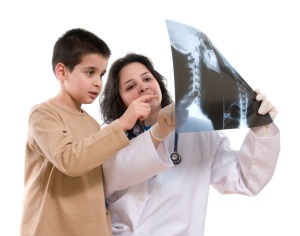Pediatric Patients: Communicating Radiation Risks Effectively
May 13, 2014
 While health care professionals should be ever mindful of the need for good communication, when it comes to making patients aware of the risks and benefits of computer tomography, that communication is even more challenging and just as important when dealing with pediatric patients.
While health care professionals should be ever mindful of the need for good communication, when it comes to making patients aware of the risks and benefits of computer tomography, that communication is even more challenging and just as important when dealing with pediatric patients.
Joshua Broder, MD, FACEP, who is an associate professor of emergency medicine at Duke University Medical Center, and Donald P. Frush, MD, chief of pediatric radiology at Duke University Medical Center; published an article on this subject in a special issue of The Journal of the American College of Radiology.
The article provides some advice for communication dealing with the risks of radiation for pediatric patients, as far as the correct tone and style of any conversations along these lines.
According to Dr. Broder, “Communicating risk is essential to the concept of patient autonomy, which is complex in pediatrics because decisions are usually made by caregivers. A decision-maker can’t make an informed decision without understanding both risk and benefit.”
Information for Caregivers
This is certainly true---information about the risk and benefits of radiation for pediatric patients is normally shared with the patient's adult caregivers. This usually means parents, but in some cases it might be grandparents, other family members, foster parents or the child's court appointed guardians.
Health care professionals must make the caregivers aware of both the benefits and the risks involved in radiation for pediatric patients. The caregivers are, after all, the decision makers regarding the pediatric patient's medical care. So, it is essential they be given all of the information they need in order to make an informed, knowledgeable decision.
Many times, the clinician who orders the procedure is responsible for furnishing the pertinent information to the caregivers of a pediatric patient. From that point, the radiologist is responsible for optimization of the procedure itself, maintaining a careful balance that takes into consideration the safety of the patients as well as the diagnostic accuracy.
Of course, it would be impossible to have this discussion about the risk of radiation before every procedure.
Layman's Terms
Dr. Broder stressed the importance of discussing the benefits and risks of radiation for pediatric patients in laymen's terms so that caregivers are able to understand, instead of using too much technical and medical jargon.
Studies have shown that a surprising number of people will not admit they don't understand something a medical professional tells them, so it behooves these professionals to be sure and make themselves clear, coaching in words and terms that can be understood by the average person.
“Physicians sometimes struggle with this, using technical terms that aren’t readily understood by patients and families,” Dr. Broder said.
Besides discussing matters in a way that can be understood by non-medical persons, the communication should also be:
- Compassionate
- Sensitive
- Courteous
- Honest
- Appropriate
Caregivers should always be asked if they understand and/or have questions. They should also be given printed material or additional online information about the procedure in question.
Perhaps the hardest part of discussing the benefits and risks associated with radiation for pediatric patients is assisting caregivers and patients to balance the short-term needs of their medical condition against long-term risk.
Dr. Broder had this to say: “The highest radiation exposures from procedures such as CT in the youngest pediatric patients still represent a small risk relative to baseline cancer risks in the population, and we need to be cautious not to make patients so fearful of radiation that they might refuse an indicated exam.”
Broder suggests asking questions about the risk, the speed of progression of the medical condition, whether or not the patient is healthy enough to defer a diagnosis without it causing a great deal of harm, and more along those lines.
Broder said that it all hinges on whether or not the risk of the condition outweighs the risk of radiation imaging. If it does, the imaging procedure should be done. According to Broder, the decision is quite complex and should be considered on a case-by-case basis by the caregivers, patient and physician.
Communication about radiation risks and benefit can be challenging when dealing with a pediatric patient, but is the key to good medical care.


